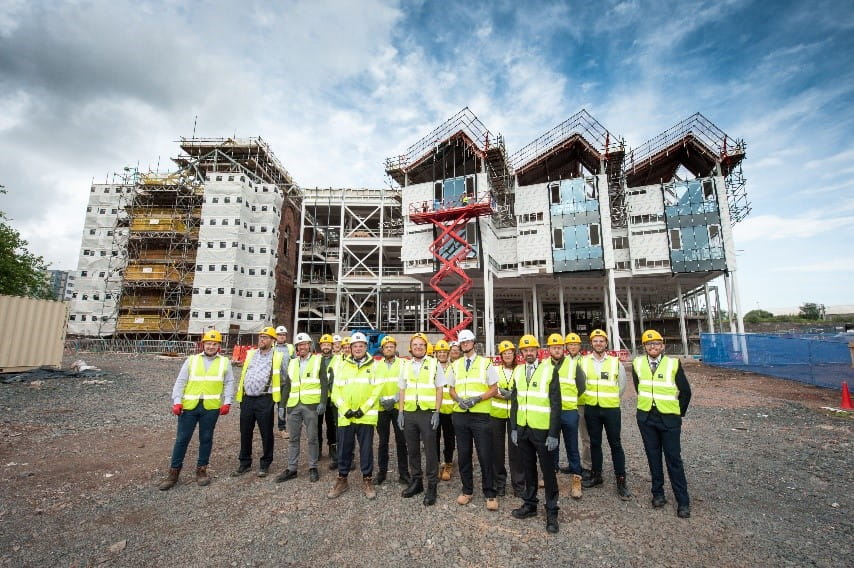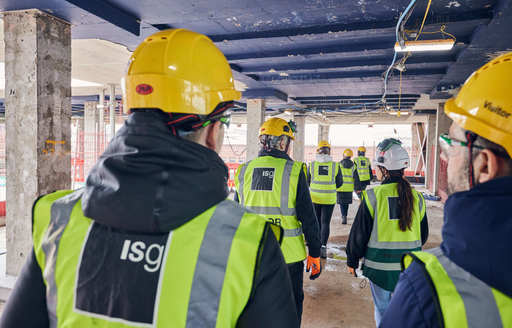
For local boy and University of Wolverhampton graduate, Liam, the chance to play a part in his former university’s future is taking him on a nostalgic trip down memory lane.
Wolverhampton. A city with a rich industrial heritage, and home of Wolverhampton Wanderers – a football club that binds its people together.
For Liam, it’s home. Having grown up in the Black Country, he has a strong connection with the area, studying Construction Management at the University of Wolverhampton and starting his own family in the shadow of Molineux Stadium. It’s a story that has seen Liam come full circle and return to his old university stomping ground, as part of the ISG team which is transforming a derelict brewery into the University of Wolverhampton’s brand-new School of Architecture and the Built Environment.
The project, which pays homage to the building’s beer-brewing history and the industrial architecture that surrounds it, owes much to Liam’s local connections. With his links to the city and its people, Liam is passionate about laying the groundwork for future generations of constructors – and there’s no place he’d rather be: “I’ve worked on projects all around the world; it’s taken me nearly 25 years to be back in Wolverhampton, doing a job that means the most to me.”
Revisiting your past is not something that many people get the chance to do. What will have changed? And what will live up to fond memories of years gone by?
The transformation of a derelict brewery building has offered Liam Davies, project director at ISG, the opportunity to take a trip down memory lane. No, he didn’t moonlight as a brewer – rather, he has strong links to the university and Wolverhampton as a whole.
The ISG team likes to have some friendly banter with Liam as the new School of Architecture and the Built Environment has many personal connections for him. As a local boy, who studied Construction Management at the university, he is passionate about creating a facility for future generations of constructors. One of them may even be his eldest son, now 10 years old, he says. “I have worked on projects all around the world," says Liam. "It’s taken me nearly 25 years to come full circle, to be back in Wolverhampton, doing a job that means the most to me.”
Liam joined ISG as a senior project manager to tender for the School of Architecture and the Built Environment project, a scheme which will see the restoration and repurposing of a Grade I listed brewery building along with the construction of a new three-storey building.
“The scope of works is specific in saying we must retain the scars of the building. We want to see the char marks from the fire, and where steelwork inside the building is cut out, the ends must be seen.”
Liam Davies, Project Director
Beyond his commitment and motivation, Liam brings with him some very practical advantages. Having worked on the renovation of the Grade I listed Royal Hospital in the city prior to this project, he has a good handle on risk and, vitally, good relationships with local specialists.
Liam recalls a visit to site when ISG was considering bidding. “We drove down Grimstone Street, had a look at the building and had a talk about it. I said: ‘We don't need to be afraid of it if we use the right people’.” ISG was awarded the contract under the Pagabo framework and started on site in October 2018. Midway through the project, the feeling of pride from the team is evident from the spectacular feeling you get as they guide you around, showcasing the full-height atrium space with the brick of the old building and the distinctive clock tower.
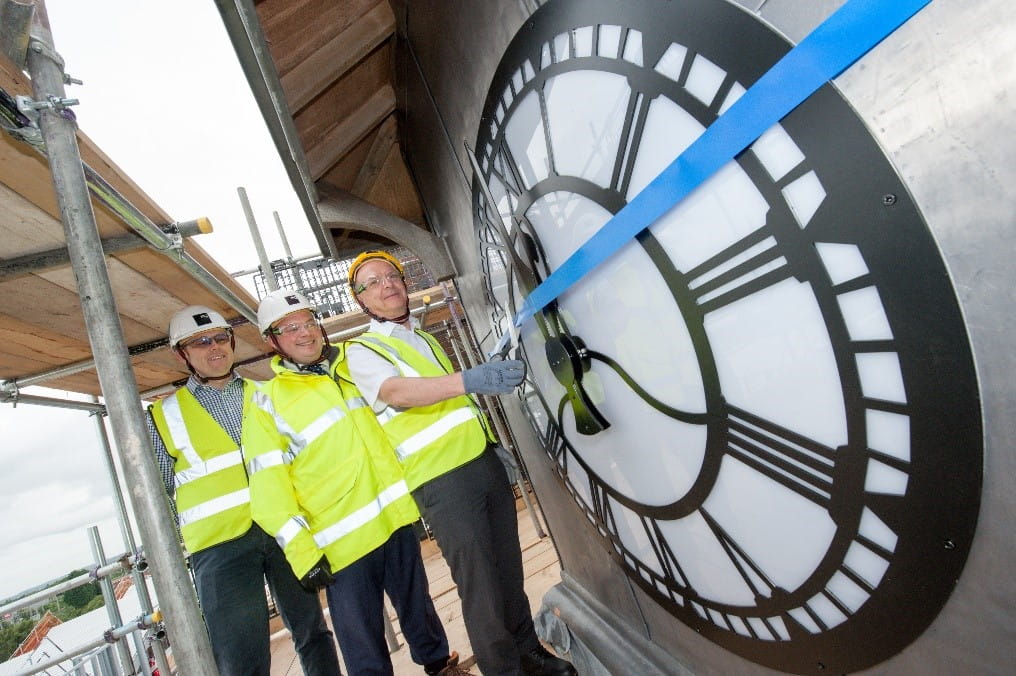
The 7,900 sq m new building will be home to a lecture theatre, specialist laboratories, workshops, ICT suites, offices, workspaces, meeting rooms and a café. With its saw-tooth roof, it echoes industrial buildings around Wolverhampton. Externally, there will be a piazza and courtyard.
The School of Architecture and the Built Environment is part of an ambitious £100m vision to create Europe’s biggest built environment campus on the 4.5ha Springfield Brewery site. The West Midlands University Technical College, for 14-to-29-year-olds, and the Elite Centre for Manufacturing Skills, are already built and open.
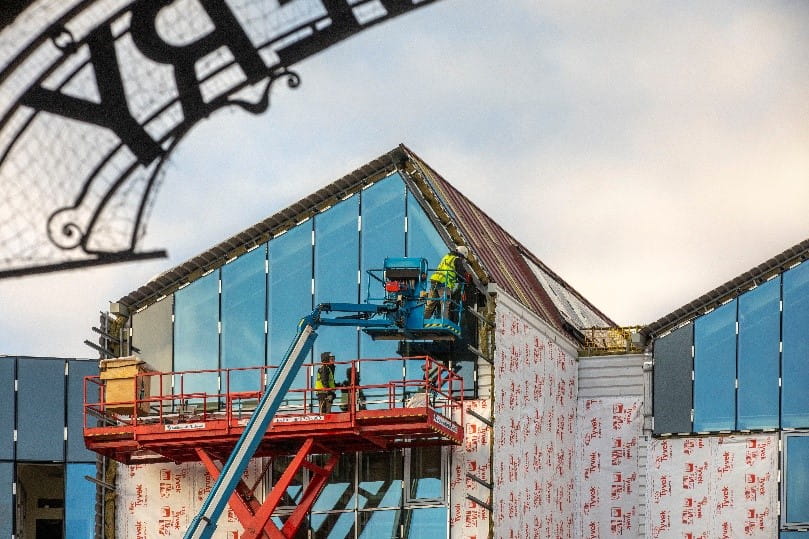
The choice of site makes an important statement for the university, which is currently conducting a lot of research into brownfield regeneration and has made it part of their agenda to ensure they are focusing on brownfield and not leaving large derelict spaces to create new.
The city-centre brewery was built by William Butler, opening its doors in 1874, and employing 900 people and producing 1,500 barrels at peak. It stopped operation in 1990. Since then, there have been several attempts to reinvent the site, not helped by a huge fire in 2004 which caused significant damage.
By the time the university purchased the site, most of the brewery buildings could not be saved. However, the redevelopment will encompass the iconic clock tower which Liam remembers always being there throughout his childhood. Part of ISG’s remit is to make sure the story of the brewery building remains visible.
“The scope of works is specific in saying we must retain the scars of the building,” says Liam. “We want to see the char marks from the fire, and where steelwork inside the building is cut out, the ends must be seen.”
“I have worked on projects all around the world. It’s taken me nearly 25 years to come full circle, to be back in Wolverhampton, doing a job that means the most to me.”
Liam Davies, Project Director
The new and old elements of this build show such a contrast of scale and speed. The new build section moves at pace with piles installed, steel frame erected, concrete floors poured and the roofing under way.
The lecture theatre, slightly sunken, is taking shape. At one corner of the ground floor is a 1.1m-thick concrete slab sitting on deeper piles and isolated from the rest of the building. Heavy-duty experiments will take place here, without the risk of vibrating the whole building.
Meanwhile in the historic building, it is a case of ‘gently does it’ with the building works. The walls are being steam-cleaned, with the pressure carefully limited to avoid moving important markings. Steel columns are being cleaned using wire brushes and elbow grease. Bricks that have blown must be carefully knocked out and replaced.
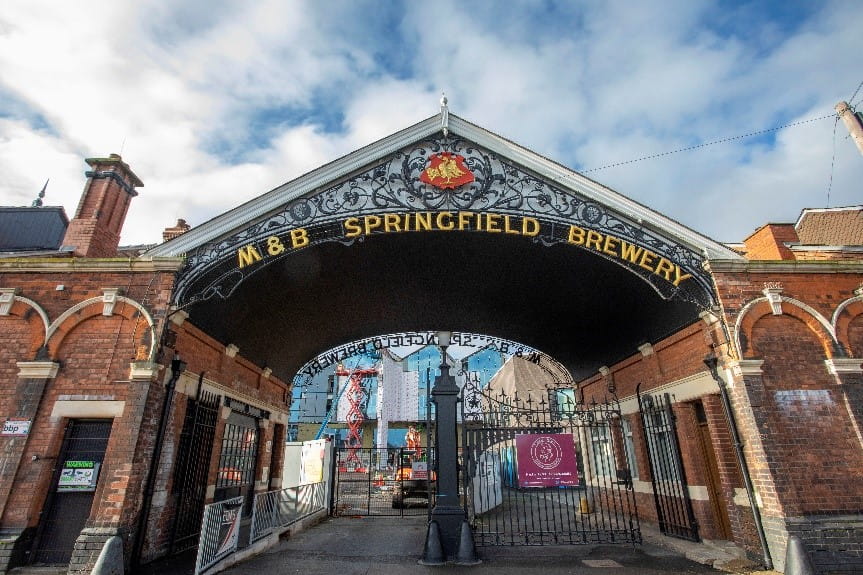
In a corner of the site, workers are cleaning up old bricks retrieved from the demolition of parts of the building. “Some of the bricks needed are hard to come by,” explains Liam. Rope bricks – which have a rope pattern on their corners – must be sourced through specialist reclamation yards. To date, around 12 different mortar mixes have been designed and approved, with the help of a mortar specialist, to match the many colours and compositions used over the years.
An important milestone in the restoration of the brewery was the renewal of the clock tower. Four new clock faces are now visible from various parts of the city. The milestone was celebrated with an event attended by the wider project team and those with community connections, which gave Liam the opportunity to explain the importance and history of this element of the build.
With the eyes of the university, his neighbours and even his brother – who also works in the local construction industry – on him, there are plenty of reasons why Liam remains ultra-focused on doing an outstanding job.
